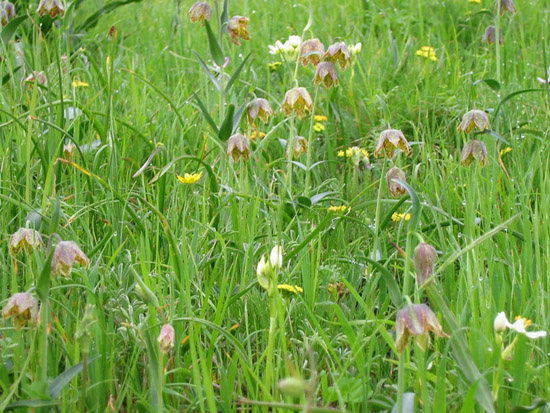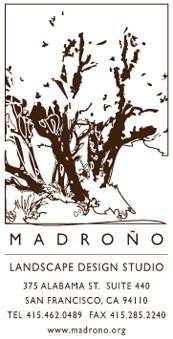 Often charming, occasionally gritty, surely up-and-coming -- witness the real estate renaissance of Bernal Heights, S.F.'s neo-boho neighborhood where once-dilapidated homes now zoom at the speed of commerce beyond the million dollar threshold. Yet a liferaft floating at the center of this frothing urban sea remains undeveloped: Bernal Hill Park, a peak with a far older balance sheet of life, death, and rebirth.
Often charming, occasionally gritty, surely up-and-coming -- witness the real estate renaissance of Bernal Heights, S.F.'s neo-boho neighborhood where once-dilapidated homes now zoom at the speed of commerce beyond the million dollar threshold. Yet a liferaft floating at the center of this frothing urban sea remains undeveloped: Bernal Hill Park, a peak with a far older balance sheet of life, death, and rebirth.
Start your walk on the south side, where all good rags-to-riches stories begin. There on the wrong side of Bernal Heights Blvd. (south of the road), a proud blooming patch of hummingbird sage (Salvia spathacea) bears up in a weed-choked vacant lot. This plant grows in oak woodlands, chaparral, and scrub along the coast of central and southern California, reaching its upper limit in the Bay Area, where it thrives; it spreads by rhizomes and makes an outstanding groundcover in both sun and shade. The lance-shaped leaves give the finest fragrance of any sage you'll find, and the dramatic pink blooms draw squadrons of hungry hummingbirds. The rogue patch in the vacant lot is the last (known) survivor of the naturally occurring species on Bernal Hill -- so if you find it, please treat it with care.
Continue north and uphill, where 20 acres of grassland house other jewels from the pre-Colombian flora. Shooting stars (Dodecatheon spp.), for example, have burst aloft early and prolifically this year; these members of the primrose family develop shuttlecock flowers pointed like rocket ships, peppering the meadow with gorgeous violet flames. The botanical name is Greek for "twelve gods," and with as many easily intergradable species in the genus, the promiscuous taxonomy of Dodecatheon feels worthy of those old landlords of Olympus. Bernal Hill is the type locality for Dodecatheon clevelandii ssp. patulum, a noteworthy subspecies that thrives on serpentine. Go see it now in plenty on the north and northwest slopes beneath the microwave tower, facing the skyline of downtown.
Rounding the tower to the west, you'll find abundant shooting stars together with johnny jump-ups (Viola pedunculata), the bearded yellow-orange flowers with wine-goblet leaves growing from deep spongy rhizomes. This cheerful harbinger of sunshine is the larval food of the Federally endangered Callippe Silverspot butterfly; both species should be hailed as hometown heroes.
Shooting stars and johnny jump-ups once reigned on Twin Peaks and Mount Davidson, Corona Heights and Bayview Hill, and other red chert outcroppings in the city; they are now greatly reduced where not extirpated, driven out by Darwinism and development. We could think of their surviving residence here on Bernal Hill as one of the city's longest-lasting and most daring real estate acquisitions.
Further up the slope, two members of the lily family heighten the drama. Swaths of Fritillaria affinis, their slender stalks hung with the pendent bells of greenish-bronze flowers, toll their golden clappers for Persephone. Indeed, this lily goes by the common name of "mission bells." The tintinnabula this year on Bernal's western flank are the best they've been in decades.

Smaller clusters of the elusive star lily or death camas (Zygadenus fremontii) rise like a constellation, or an omen of unknown import, with multiple clawed white flowers held aloft on foot-tall candelabra. The blooms of the Zygadene have delighted generations of native plant peepers, but the bulbs may spell foreclosure for any fool who tries to eat them; these highly toxic plants have caused death in cattle and children.
Red striated cliffs, the raw pieces of petrified sea-floor upthrust, make a comfortable home for the silver lupine (Lupinus albifrons), whose ability to survive these tough conditions belies the delicate look of its feathery foliage. The luminescent bloom alone recommends this hardy perennial for the garden, but the plant warrants further note as the larval foodstuff of the rare Mission Blue butterfly. This endangered creature, no longer found on Bernal Hill, does persist nearby on Twin Peaks and San Bruno Mountain; gardeners in those neighborhoods should consider planting silver lupine to attract and support the protected butterflies, while green thumbs elsewhere might do so just for the show of solidarity.
Most of our native bunchgrasses were overwhelmed long ago by waves of invaders, otherwise known as weeds, those exotic annuals from overseas: wild oats, ripgut brome, soft chess, and Italian ryegrass, among many others. Annual grasses live fast, setting summer seed that will germinate next year, and die young, leaving in the meantime the dead stalks of a brown-tinted landscape that now so characterize California. Perennial bunchgrasses, by comparison, retain a shade of green throughout the year.
As the rains come and go, so follow the life-cycles of the grassland, weeds and natives alike. Winter downpours recharge the aquifer and drive the greening of the hills, like a blank canvas prepped for the colorful blooms of spring. But the siege of summer's drought will see native plants go dormant, a misleadingly drab tableau. In fall, unsuspecting visitors might mistake a dry hill for dead, not knowing what thrilling life lurks in the roots.
That any natives survive at all on Bernal Hill testifies to their strength and tenacity, but the numbers are stacked against them. A vegetation survey taken in 2000 by the Natural Areas Program marked a petite prairie of purple needlegrass (Nassella pulchra) that anchored a micro-ecosystem "dominated by native species." This oasis totaled 0.07 out of 20 acres, or less than a hundredth of a percent -- and the rest is wild oats. But other native grasses found sparingly here include Festuca rubra, Danthonia californica, Melica californica, Koeleria macrantha, and Elymus multisetus.
Clinging to life on Bernal, Nassella pulchra also survives in diminished numbers throughout California's coastal parries and inland valleys. This compact 1- to 2-foot golden-green bunchgrass with shimmering purple inflorescence in summer was recently named the state grass, Proposition 215 be damned.
For long-term stability on a sunny hillside, consider planting native bunchgrasses as the foundation for a coastal prairie. Use any or all of the above-named species, one plug every 3 feet with some wildflowers in between, and interplant 1 perennial per 5-10 grasses. Help it with water through the first summer, and weed it regularly for the first year or two, then stand back and watch the succession of your low-maintenance, irrigation-free grassland. Presto -- a remarkable improvement in the property.
Gardening with natives delivers benefits on multiple levels, but perhaps the deepest pleasure derives from the question of identity. These plants lived here before the white man, before the red man; for longer than human history their striking beauty has defined this part of the world, this land we call home. Planting them together in your back yard is like giving your garden a warm-up jacket with "San Francisco" emblazoned on the breast.
* * *
Geoffrey Coffey would like to buy a fixer-upper in Bernal Heights. He is the founder of the Madroño landscape design studio and a freelance writer for the San Francisco Chronicle.

